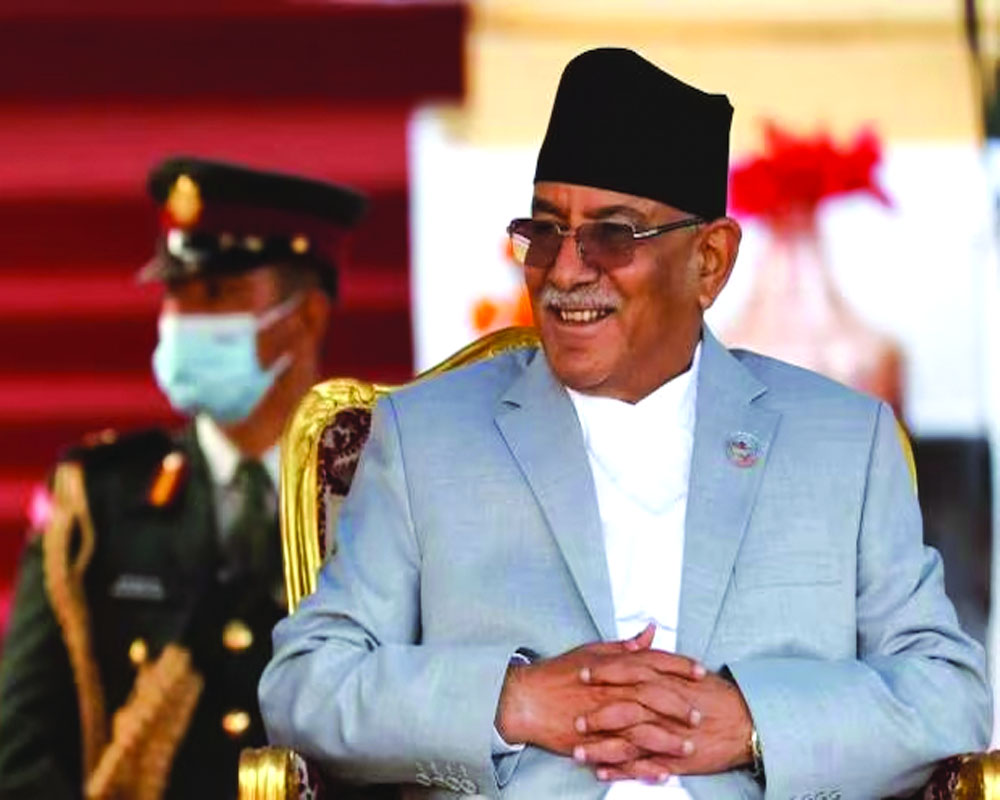Political engagement between the countries is missing for some time now. The historicity of bilateral relations will depend on Prachanda’s longevity as PM
PM Pushpa Kamal Dahal Prachanda will finally arrive today on a four days visit. Prachanda’s first visit was a state visit when he came after the 10 April 2008 Constituent Assembly elections to 575 elected seats (out of 601) after the monarchy was dismantled and Nepal declared a federal democratic, secular republic. Prachanda who won peace after ten years of civil war, became Nepal’s charismatic leader and beloved hero, his party winning 227 seats more than Nepali Congress (110)and CPN UML (103) combined.
It was a rude shock for India which had put its money on Nepali Congress. Still, it tried to adjust to Maoist ways to give Prachanda a grand welcome with the expectation that he would be sensitive to India’s concerns and national interests. That hope was belied as Prachanda had ideas of a People’s Republic chasing which he was forced to resign. The rest is a legend. In the second CA elections in November 2013, Maoists won 81 seats. Prachanda’s second visit was in 2016-17 when he switched to NC from UML for power-sharing with NC PM Sher Bahadur Deuba. After the 2017 elections, Maoists won 53 seats and were forced to join the Left alliance which won a nearly two-thirds majority but Prachanda’s hopes of becoming Prime Minister in a power-sharing deal with PM KP Oli never materialised.
In November 2022 elections his party slumped to 32 seats but all through the electoral cycles, CPN (Maoist Centre) even with declining numbers, remained the number 3 party – the kingmakers – with NC and UML alternating as the single largest party. Prachanda’s reduced strength and power had not dimmed his ambition to be the prime minister. He demonstrated political dexterity in switching coalitions earlier this year to remain PM. Nepal’s mixed electoral system makes a single-party majority unlikely. People
frustrated with the non-performance of older parties, voted TV anchor, Rabi Lamichhane, as leader of the fourth largest Rashtriya Swatantra Party (22 seats) and the rapper Balen Shah, Mayor of Kathmandu humbling NC, UML and Maoists.
The three by-polls held in April in which RSP won two seats with overwhelming numbers including one from an NC stronghold have rung alarm bells for all political parties. Prachanda wants to revive the fortune of Maoists with India’s help. That is why Prachanda wants to make his present visit historic and a game changer in India-Nepal relations for which he has to win back India’s trust and most of all, the trust of the people of Nepal. He is now part of the eight-party coalition led by NC, along with CPN (Unified Socialist), Janata Samajwadi Party, Loktantrik Samajwadi Party, Janmat Party, Nagarik Unmukti Party and Rashtriya Jan Morcha. It is a different Prachanda who as Prime Minister leads the coalition and his party. He has to undo the pro-China image that he shed long ago that went unnoticed by New Delhi’s political elite. This will not be easy in a Left-Right coalition.
Prachanda has to remould his party with a makeover of leadership. India should be impressed that Prachanda unlike in 2008 when he went to China first, has this time declined Beijing’s invitation for the Boao Forum in March and declared his intention to visit India first despite the scheduling and cabinet formation difficulties. New Delhi has not sent the right signals by failing to give an earlier date for his visit. It would have added to the credibility and stability of the coalition government. During the last Prime Ministerial visit of Mr Deuba last year, no major agreements were signed. Wait, watch and act after the November 2022 elections were India's policy. Mr Dahal has proved his nimbleness by securing three votes of confidence, signing two Common Minimum Programmes and getting the budget passed last Monday. He is also seen to be acting against corruption.
One of the key expectations of Nepal is a more fair and liberal power trade agreement. At a power summit held in Kathmandu in April, Nepalese power traders complained that India had not provided full access to power markets as per the MoU of 2014. New Delhi has so far permitted the sale of 452.6 MW whereas Kathmandu wants to sell 1000MW of power. There are other restrictions to the sale of power especially from projects with any connection with Chinese companies or Chinese contractors. Besides trade with India, it wants to diversify – sell to Bangladesh also. Connectivity is the other big expectation.
The DPR of the 136 km Raxaul-Kathmandu railway project spurred by an earlier Chinese proposal of a Railway from Kirung to Kathmandu has to be progressed It is estimated to cost USD 2.5bn for which Nepal wants a grant. Nepal is also interested in India setting up a fertilizer plant and or a pipeline similar to the petroleum pipeline from Birgunj to Amlekhgunj. The Pokhara international airport built by the Chinese with a China Eximbank loan remains confined to domestic use because of Indian reservations. Another issue that may come up is Agniveer due to which Gorkha's recruitment from Nepal is in suspended animation. Overall 12 MOUs are to be signed which is historic.
Political engagement between leaders missing for some time now requires restoration. The historicity of bilateral relations will depend on the stability of the coalition and Prachanda’s longevity as PM. In some ways they are interdependent.
(The writer, a retired Major General, was Commander, IPKF South, Sri Lanka, and founder member of the Defence Planning Staff, currently the Integrated Defence Staff. The views expressed are personal)


























